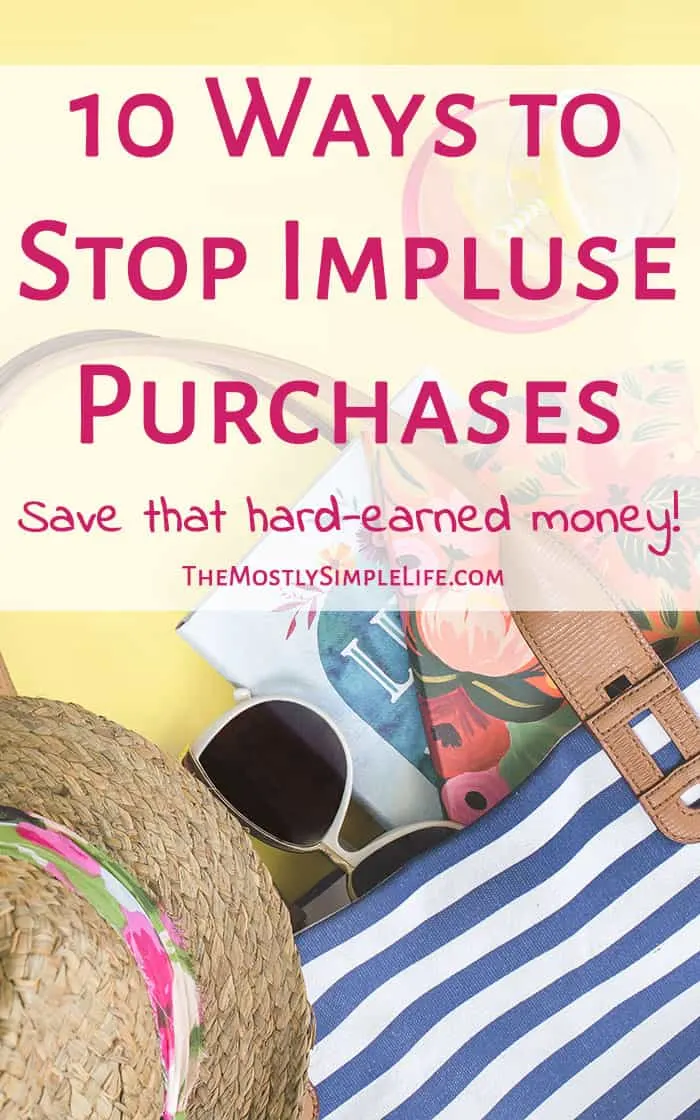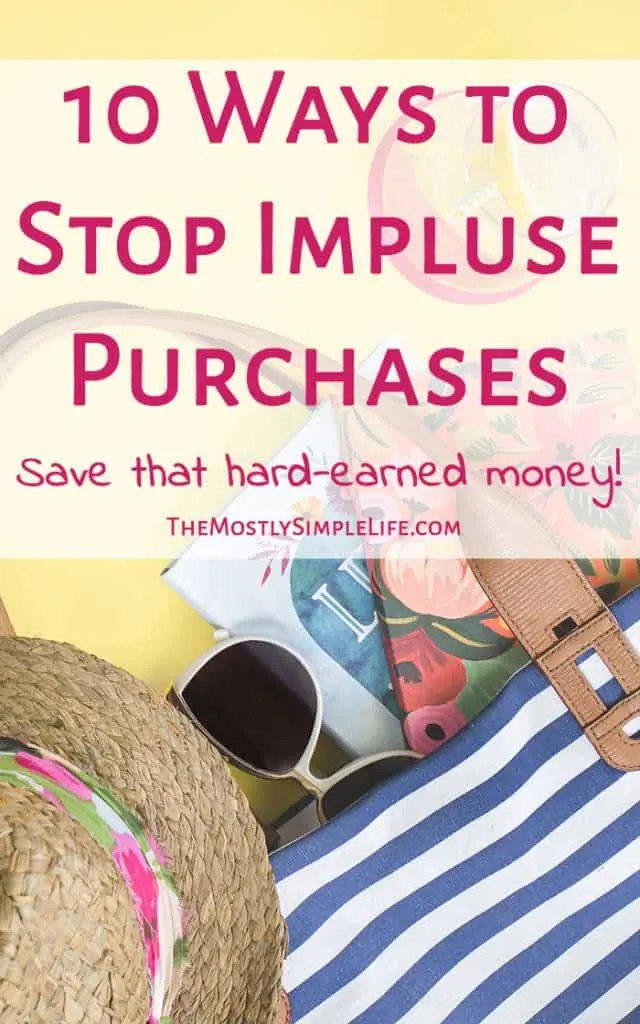Impulse purchases can kill your budget so quickly!
When you have that thought of “where did all of my money go?” it’s almost always because you’ve made some impulse purchases.
Just so we’re all on the same page, I’m going to define an impulse purchase as buying something you weren’t planning on buying or that you don’t have the money budgeted to buy. It could be a candy bar. It could be a TV.
An impulse purchase often doesn’t feel like an impulse purchase because we can usually justify it because we need it, or at least could use it. The fact is, if you don’t have the money to buy it and it wasn’t a planned purchase, it’s an impulse and will throw your budget off.
Could I use a new pair of shoes? For sure. I have a pair in super rough shape that I’ll need to replace soon, but my financial priorities are somewhere else at the moment.
Would I enjoy going out to eat tonight? Absolutely. I’m tired and don’t feel great, but I’ve already spent my eating out money and I have a kitchen full of perfectly good food.
Do we need all of these groceries? Well, we certainly need groceries, but just the ones that I planned on buying that will be turned into meals. I might have thrown a bunch of extras into the cart because they looked good.
You get the idea.
It can be hard to stop impulse purchases when they’re in disguise as something we could use and feel like we need. Here are things that help me:
How to Stop Impulse Purchases
1. Shop with a List
Always shop with a list.
I 100% recommend that you spend a few minutes before going grocery shopping to write down the meals you’re going to make and then make a list from there of what you will need to buy to make those meals. It’s super basic meal planning.
Take a look at the fabulous meal planning service I’ve started using here.
It will keep you from wandering the isles throwing whatever looks good into your cart. Buying whatever sounds good usually means that you’ll spend way more money than you need to and you’ll get home with tons of food that doesn’t go together and equal a meal.
Shopping with a list isn’t just for grocery shopping.
Keep a running list in your purse or in your phone of other things you need as well. When your toddler needs shirts, when you need a new spatula, when your husband needs dress pants… Write it on an ongoing list of things that you need.
Whether you shop at the mall or at a thrift store, you’ll know what you need to be looking for. Shopping with a list of clothes or household items that you need will keep you from making impulse purchases of things just because they look good or are on sale.
2. Set a Budget & Stick to It
How do you know if you’ve spent too much or how much you have left to spend if you don’t have a budget?
Having a budget is a wonderful thing! It’s just a plan for your money. It doesn’t have to be restrictive. It just means that you plan how you’re going to spend so that you can accomplish important things with your money and so that you don’t have to stress about money.
Here’s the hard part: Stick to your budget.
This is where I have a rough time. I print out my budget spreadsheet every month, but I’m not always great at taking the time to track my spending or sticking to the budget. I get tired and lazy by the end of the month, and sometimes things don’t go as planned.
It’s always worth the effort to stick to your budget.
Enter your email below if you’d like to try using the spreadsheet I use to create our budget and track our spending:
[convertkit form=4899234]
3. Add up as You Shop
The best way to stick to your budget while out shopping is to add things up as you shop. This can feel like a bit of a pain in the butt, but it is so effective.
You don’t have to be super exact and walk around the store with a calculator if you don’t want to.
You can just add things up in your head as you put them into your cart, rounding prices up or down. You’ll at least be within a few dollars of the actual total when you get done.
I read this awesome tip in a Facebook group that I’m a part of: They used a tally counter to add up their purchases as they shopped. Just round each price up or down and click the button to add to your total. So if cheese is $2.75, press the button 3 times. The genius part of the suggestion was that they gave the tally counter to their kids so that the kids could press the button. It gave them a relative total of their shopping trip and kept their kids engaged and busy too (we don’t have kids, but I’ve noticed that they seem to get fussy if you take them grocery shopping 🙂 ).There are also apps that you can get for your phone that do the same thing, but I find the physical button on the tally counter very satisfying to press.
4. Plan for a Treat
I find that I’m less likely to make an impulse purchase if I plan for a treat.
I might be more careful of what I buy at the mall because I’m planning on getting a smoothie, which is a fun treat so I don’t really need anything extra.
It’s easier for me to stick to my list and only shop for the necessities when I’ve got money set asie for a little something fun.
A treat might be planning to buy a chocolate bar when you go grocery shopping or stopping for a latte on the way home.
It doesn’t cost much and I don’t go over my budget at all, but it’s fun.
I’ve literally been about to make impulses before and I stopped myself from grabbing something because I thought, “Well, I’m already going to get this little treat, so I’m good. I don’t need this too.”
5. Don’t Shop for Fun (or browse other isles)
I’ve said it many times: Don’t make shopping your hobby. It’s not something to do just because you’re bored.
I try not to go shopping just for fun. It’s harder for me not to wander through extra isles though.
The big grocery store in West Michigan is called Meijer and they have everything. They sell clothes, toys, electronics, home decor, craft supplies, etc. It’s comparable to a Walmart.
So when I get groceries there, it’s hard not to just get groceries. If I have a few extra minutes, it’s easy to browse some of the fun isles. There’s nothing wrong with browsing, but it does tempt you to buy things you weren’t planning to buy. If I know there’s no room left in my budget for extras, it’s best to just stay away.
6. Plan Easy Meals
Getting unplanned takeout usually results from me not wanting to put in the effort to cook anything.
Some days (maybe most days), I don’t have the energy to spend more than 10 or 15 minutes in the kitchen.
When I plan my meals for the week, I make sure to plan simple, quick meals. I also plan one or two ridiculously easy meals like frozen pizza or rotisserie chicken. Sure, convenience foods cost a bit more, but they’re far less expensive than going out to eat or getting takeout.
7. Remind Yourself of Your Goals
To keep yourself from making impulse purchases, keep your goals in mind.
Are you trying to pay off debt? Save for a house? Get to the end of the month without running out of money?
Every time you are in line to check out, look at what you’re buying and think about your goals. Are you about to buy anything that will set you back from accomplishing your goals?
It’s super helpful to put a sticky note in your wallet with your financial goals written on it. You could even wrap it around your credit card so that you have to see it every time you want to spend money.
8. Budget Your Fun Money
Like I said, budgets don’t have to be restrictive. A budget is just a plan for how you’re going to spend your money. Don’t forget to budget for some fun.
Austin and I each get an “allowance” each month that we can spend however we want. I usually end up spending mine on house decorations, craft supplies, or accessories.
When you have room for fun in your budget, you can be impulsive and spontaneous and enjoy it. Fun money in your budget will keep your spending in line while still allowing you to have fun.
9. Unsubscribe to Sale Emails
Stop looking at those sale emails if you don’t have money to spend! Sale emails are so tempting. How often have you gone to a website just to browse because you got an email about a sale? I’ve done it so many times.
You know what? There’s always a sale going on. Always.
I’ve unsubscribed to most store emails.
When I want to shop online, I either re-sign up for sale emails or I just google search for a discount code to make sure I still get a great deal.
10. Don’t Let Websites Save Your Info
This is small and silly, but has honestly kept me from making impulse purchases online.
I don’t let websites save my billing and credit card info. Not only is this smart and security conscious, because customer info on websites can get hacked, but it makes me think twice before checking out.
The fact that I have to get up, go grab my wallet, and enter in by billing info to check out has kept me making a purchase a few times. Yup, I’m lazy 🙂 Try this, though. If online shopping is your downfall, it might help more than you think.
Related Posts:
Our Actual Budget: Less Than $1500/Month
The Simple Way We Track Our Spending on a Tight Budget
How to Earn Cash Back on Fruits, Veggies, and Store Brand Foods
⇒ What kinds of impulse purchases do you make? What has helped you to think twice?




Erin | A Welder's Wife
Monday 13th of February 2017
These are all good tips. One for me is to go grocery shopping with a full belly! I am the worst about purchasing food out of impulse! Unsubscribing from sales emails is very important for me to not impulse shop as well! That has cut down on a lot of my shopping these past few years.
Christine
Tuesday 14th of February 2017
Shopping with a full belly is a good one! I can't be too full to shop otherwise I talk myself out of buying things that we need because I'm not hungry and nothing sounds good :)